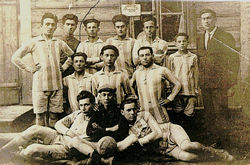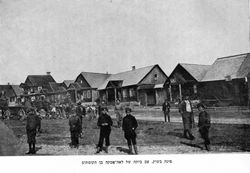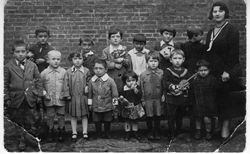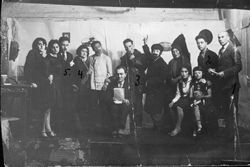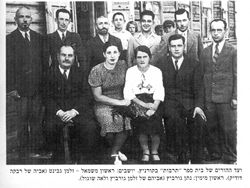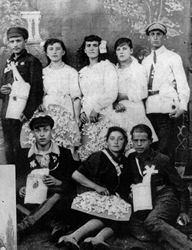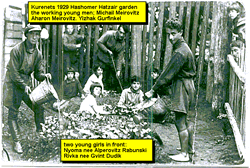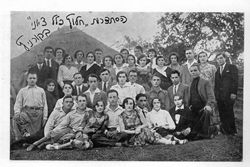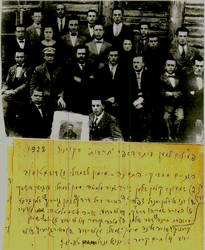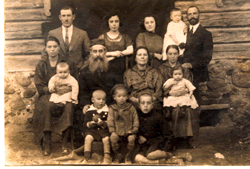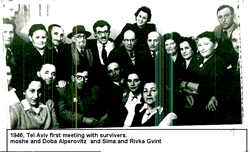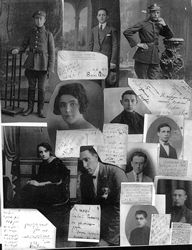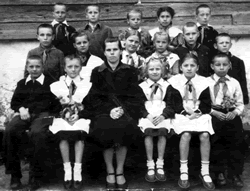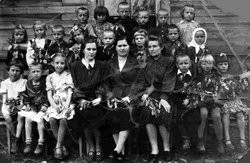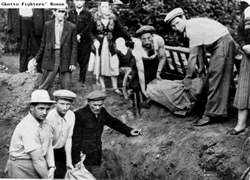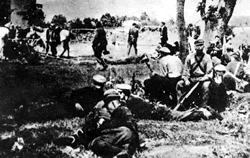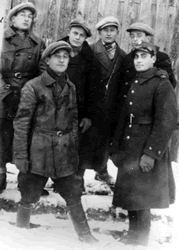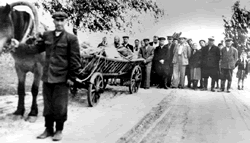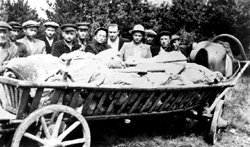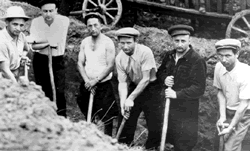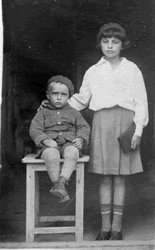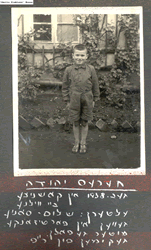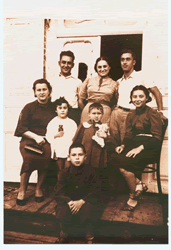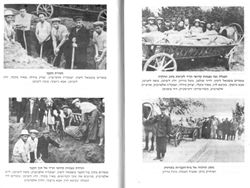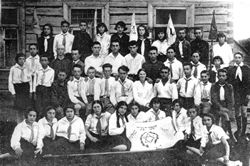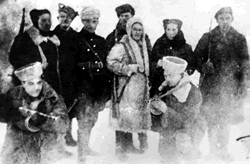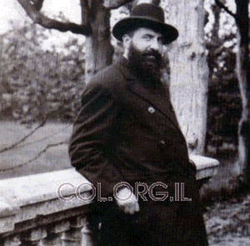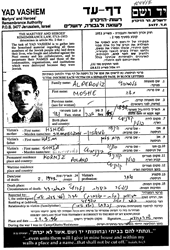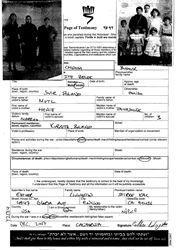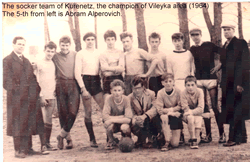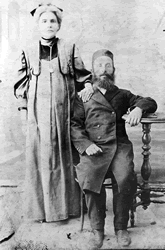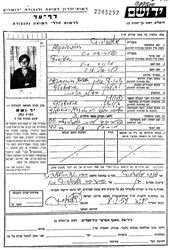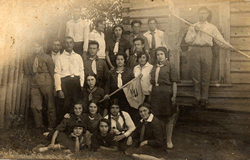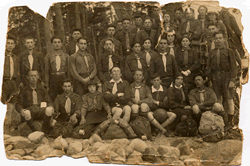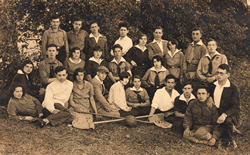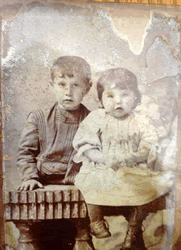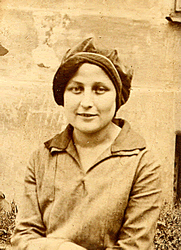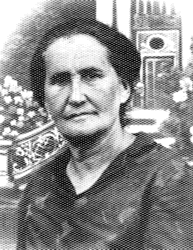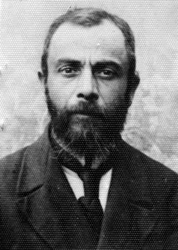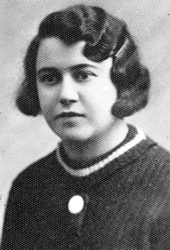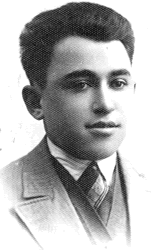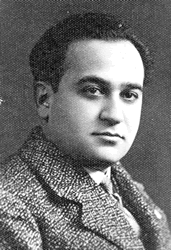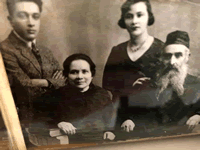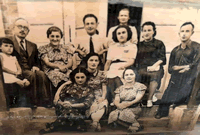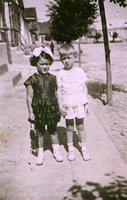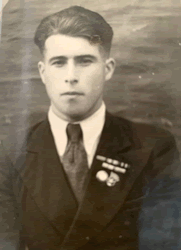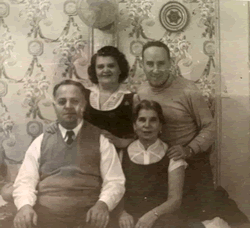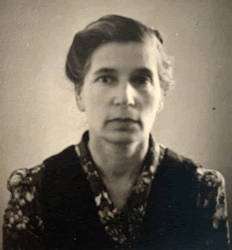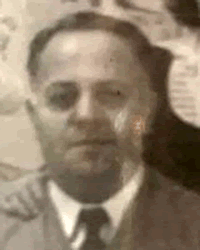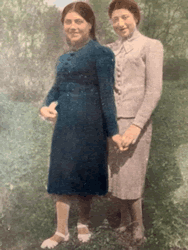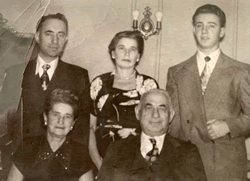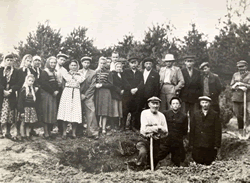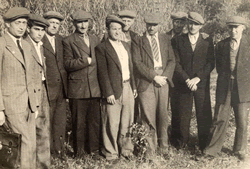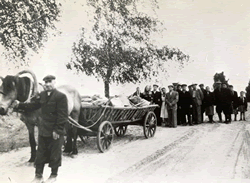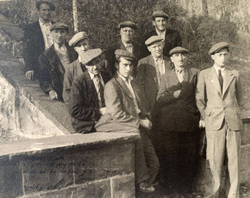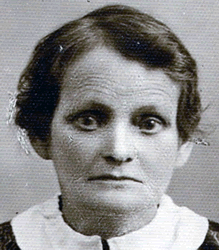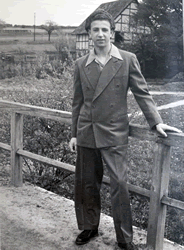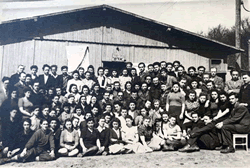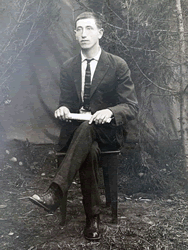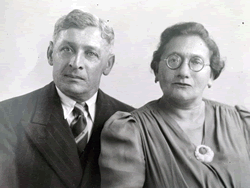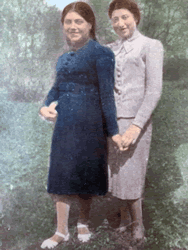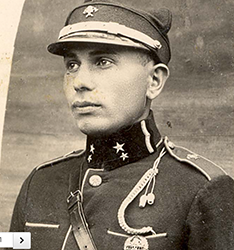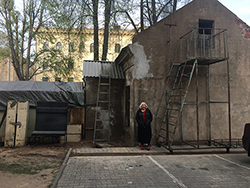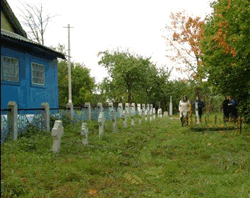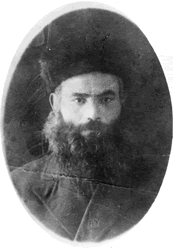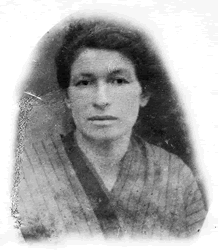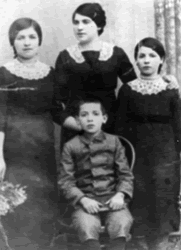|
#kur-1: The Youth Movement by The Rock |
#kur-2: Kurenets soccer team 1920s |
#kur-3: Kurenets during World War I |
|
#kur-4: Nursery School run by Rashka Shulman c.1931 |
#kur-5: A Theatrical Production in Kurenets c.1930 |
#kur-6: Gurevitch Family |
|
#kur-7: PTA members of Kurenets' Tarbut School |
#kur-8: Summer camp 1920. Second from left; Bela daughter of Aharon and Rachel Shulman, third from left; Chana daughter of Naftali Alperovich |
#kur-9: Kurenitz firefighters' parade. |
|
#kur-13:
|
#kur-14: Youth Movement |
#kur-15:
|
|
#kur-16: The Alperovitz family |
#kur-17: Meeting of Kurenets natives in Israel after the war. |
#kur-18: Pictures and mementos from Kureneters from around the world |
#kur-19 Maryna Zhauniarovich <marina_sea88@mail.ru> wrote; |
#kur-20: Shurik Kurenetz School Kurenets after the war; Shurik CARMEL (nee Alex REITSHTEIN) is third from the bottom right. |
#kur-21:The bodies of 54 Jews from Kurenets who were murdered during the Nazi occupation, exhumed to be transferred to the town's cemetery for reburial. Photographed in 1956. |
#kur-22: A partisan unit during the war. Moshe Kramer of Kurenets is amongst |
#kur-23: Before the war. |
#kur-24: Family and friends returned to Kurenets in order to relocate the remains of ones they had lost. Gutel Gordon is in front. |
#kur-25: Family and friends returned to Kurenets in order to relocate the remains of ones they had lost. |
#kur-26: Family and friends returned to Kurenets in order to relocate the remains of ones they had lost. |
#kur-27: Family and friends returned to Kurenets in order to relocate the remains of ones they had lost. |
#kur-28: Chiale and Stanley Sosensky. Brave Chiale perished on 9/9/42 in Kurenets |
#kur-29: Jehuda Cheres. |
#kur-30: Emma and Edna Zivoni visit Kurenets before the war. |
#kur-31: Family and friends returned to Kurenets in order to relocate the remains of ones they had lost. This mission was carried out in secret for fear that the government would disallow their efforts or that people living in the surrounding area would return to search the remains for riches as they had done before. the surviving Jews of kurenets in the 1950s' taking the bones of their slaughtered brothers and sisters to a Jewish burial. on the top right picture, left to right; Leizer Shulman, Gutel Gordon,Zelig Liberman,Moshe Liberman, Aba Naruzki, Akiva Levin, Meir Mekler, yitzhak Fidler, Yankle Alperovich, Orzhik Alperovich, Moshe Mordechai Dinerstein, David Zimerman. picture on top left- left to right; yankle Alperovich, yizhak fidler, Meir Mekler, Zelig Liberman,Aba Naruzki, Moshe Liberman |
#kur-32: During the German occupation in the first world war (1917), with the German teacher bottom left to right; Leika Meirovitz, Chana Alperovitz, Batia nee Gurevitz Bender, Rachel Alperovitz, Ema nee Alperovitz Zivoni. middle; Henya (Menachem Mendel's) Kramer, ?, The German teacher, Feygel Alperovitz, Frumka Meirovitz, ?, Feya nee Alperovitz Rubin, the boy is the son of Zipilovitz. others are unknown. |
#kur-33: #so6: Ken Hashomer Hatzair (Socialist- Zionist youth movement) Kurenets 1929; sitting right to left:Sara nee Meirovitz Eizen, Luba nee Gurevich Bardan, Zlata Zimerman, Chana Alperovich, Bela Meltzer, Batya daughter of Rabbi Oshpol, Chaya Sara Shmukler, Dvusha Kopilevitz, Daughter of Shlomo Mayzel, Fraydel Zimerman. Second line sitting; r to l :Michael Meirovitch, Shlomke Alperovitz, Nechamia Alperovitch, Israel Gvint, Dvushel Zokovski, Aharon Meirovitch, Yitzhak Gurfinkel, ?, Hirshel Alperovitch, Eliyahu Zimerman, Standing next; Yechiel Alperovitch, ?, Third row right to left; Zev (Wolf) Rabunski, Henya Dimenstein, Chaim Yitzhak Zimerman, Shlomo Mindel, Shmuel Limon, Yermiyahu Alperovitz, Shimshon Zimerman, Velvel Rodinski, Aharon Alperovitz, Yakov Dinerstein, Yosef Markman. Top row R to L; ?,?,?, Rosa nee Chosid Rabunski, Mendel Levins' daughter, Menuchka Kopilovitch, Chaya Altman, ?,?, Sara Eisak. |
| #kur-34: A group of Jewish partisans in the forests of the Polotsk (Polatsk) Belarus.Most of them from Kurenets; Alperowicz Shimon, Dinersteinsisters; Jente and Rachel; Makarow Dina, Dr.Cirinski Meir, Kalminski Ze'ev |
#kur-35: Rabbi Yaakov Landau Z"L ( Av Beit Din of Bnai Brak) was born in |
#kur-36: Sitting second from the right; Malka Kremer. Malka perished with her |
#kur-37: Moshe Alperoviz was born in Kornitz in 1898 to Haim and Hinde nee Shmoelzon. He was a merchant and married to Sonia. Prior to WWII he lived in Kornitz, Poland. During the war he was in Kornitz, Poland. Moshe perished in 1943 in Narocz, Poland at the age of 45. This information is based on a Page of Testimony submitted by his granddaughter Sarah |
#kur-38: Ite Chodosh nee Budgor was born in Svir to Motl and Henie nee Patashnik. She was married. Prior to WWII she lived in Kurnic, Poland. During the war she was in Ghetto. Ite perished in the Shoah. This information is based on a Page of Testimony (displayed on left) submitted on 01-Dec-2007 by her niece Esther Levingston, a Shoah survivor tan |
#kur-39: Maryna Zhauniarovich wrote;.. I was interviewing older people of Kurenets to find out the names of the people in the pictures you've sent to me ------------- #kur-39, and few of the persons specified are incorrect. I was Upper row, left to right: Shlomo Alperovich |
#kur-40: Moshe David Alperovitz and his second wife. |
#kur-41: |
#kur-42: Hashomer Hatzair Kurenets |
#kur-43: Members of Hashomer Hazair in Kurenets in 1929. |
#kur-44: Members of Hashomer Hazair |
#kur-45: Maurice Leo Zimmerman Son of Yosef Zimerman and Itke Zimerman |
#kur-46: Chaia Stirel Alperovitz 1910= 1942 perished in the holocaust |
#kur-47: Esther Kagan nee Finkel was born in Rakow, Poland to Shalom and Tzvia. She was a housewife. Prior to WWII she lived in Kurzeniec, Poland. Esther was murdered in the Shoah. This information is based on a Page of Testimony submitted by her daughter, Tzvia Even Shoshan |
#kur-48: Rafael Kagan (1882- 1942) was a cantor and a shochet in Kurenets. He perished in the holocaust |
#kur-49: Shoshana Kagan was born in Korzeniec, Poland in 1912 to Rafael and Gitel. She was a bookeeper and single. Prior to WWII she lived in Korzeniec, Poland. Shoshana was murdered in the Shoah. This information is based on a Page of Testimony submitted by her sister, Tzvia Even Shoshan |
#kur-50: My parents; Rivka Kagan (born Levitan in Dokshitz) and Elhanan (Hune) Kagan born in Kurenits in 1916. My parents came to Israel on 1949 after spending the war period in Russia. I am named after the brother of my father. Their father was Eliyahu. |
#kur-51: Joseph Kagan was born in Kurzeniec, Poland in 1910 to Rafael and Gitel. He was a bookeeper and single. Prior to WWII he lived in Kurzeniec, Poland. During the war he was in Kurzeniec, Poland. Joseph was murdered in the Shoah. This information is based on a Page of Testimony (displayed here) submitted by his sister, Tzvia Even Shoshan |
#kur-52: Abram Kagan was born in Lebadove, in 1906 to Rafael and Gitel. He was a hebrew teacher and single. Prior to WWII he lived in Kurnik, Poland. Abram was murdered in the Shoah. This information is based on a Page of Testimony submitted by his sister, Tzvia Even Shoshan |
#kur-53: Emma and her brother Eliyahu with their parents Mendel and Nechama Risha Alperovitz. Only Emma survives in Israel Eliyahu and the parents perished in the holocaust. |
#kur-54: Emma Zivony nee Alperovitz and Zvia Even Shoshan nee Kagan visiting their families in Kurenets in 1938 |
#kur-55: Yuval Even Shoshan and Edna Litvak nee Zivony during their visit to Kurenets in 1938.Their mothers traveled with them from Eretz Israel to meet their grandparents and uncles in Kurenets, 4 years later all the relatives in Kurenets were murdered by the nazis. |
#kur-56: Mendel Rabunski (Chana nee Pastanovich's nephew) born in 1927 fo Yitzhak Rabunski and Leike (Leah Lisa). A sole Holocaust survivor and resistance and heroic Red Army fighter against the Nazies Brother of Shmuel (Muli) Rabunski and Chaia Rabunski from Kurenes who perished with the parents in the Shoah Submitted by his cousin Mendel Fidler and his daughter Mina Nemirow |
#kur-57: Chana and Yitzhak Fidler in the front and friends from Kurenets Submitted by Mendel Fidler and his daughter Mina Nemirow. |
#kur-58: Holocaust survivor Chana Fidler born in Kurenets in 1896 to Pesach and Mina Pastanovich. Mother of Minya Fidler (perished in the shoah); Sara Fidler killed during a lightning storm in Kurenets; Isar Fidler ( perished in Postavy) and Marvin Mendel Fidler who survived |
#kur-59: Yitzhaak Itza son of Isar and Yasha Fidler was born in Kurenets in 1897 he passed away in New York in 1975. A survivor, husband of Chana |
#kur-60: Sisters Sara Fidler who perished by lightning in her home in Kurenets in 1940 at the age of about 14/15 and Mina Fidler who was murdered at age 21 in 1942 in Vileyka at the hands of the nazis.Their brother Isar Fidler also perished while fighting the nazis in Posravy. Picture submitted by their brother Mendel Marvin Fidler who survived with the parents Yitzhak Fidler and Chana |
#kur-61: Mendel (Marvin Fidler who was born in Kurenets in 1931 is standing on the left. The women pictured are sisters Chana Fidler (top middle next to her son Mendel) and |
#kur-62: The survivors who returned to Kurenets take the bones of victims to a permanent mass gravesite .Submitted by survivor Mendel Fidler and his daughter Mina |
#kur-63: The survivors who returned to Kurenets left the area and waited in a D.P. Camp for visas to immigrate.They had a memorial service for the victims from Kurents. Submitted by survivor Mendel Fidler and his daughter Mina |
#kur-64: The survivors who returned to Kurenets take the bones of victims to a permanent mass gravesite .Submitted by survivor Mendel Fidler and his daughter Mina |
#kur-65: The survivors who returned to Kurenets left the area and waited in a D.P. Camp for visas to immigrate.They had a memorial service for the victims from Kurents..Submitted by survivor Mendel Fidler and his daughter Mina |
#kur-66: Bela Alperovich nee Zaidel born in 1887 perished in the holocaust in Kurenets 9 9 1942 |
#kur-67: Mendel Fidler, a survivor from Kurenets in 1948 at 17 years old in a Displacement camp in Germany waiting |
#kur-68: a group of young survivor in the Displacement camp that attended the ORT school in front of the ORT building. |
#kur-69: Mendel's uncle Yakov Laib Pastanovich (Chana's brother). This photo is from approximately 1920. |
#kur-70: Mendel's paternal uncle Meyer Fidler. Older brother, of Mendels father. Mever went to England before WWI |
#kur-71: Sisters Minya Fidler (Minya perished in the shoah) in Vileyka at age 21 in the spring of 1942); Sara Fidler (was killed during a lightning storm in Kurenets at age 14 in the in 1940) |
#kur-72: Chaim Zalman born in 1903 to Chaia Zipa and Moshe Binyamin Alperovich. He was killed in 1943 with his wife Chana Tzipa and baby son Reuven during their escape from the Nazis. |
#kur-73: Author and playwriter Laura shaine Cunningham by the old: Rabbi’s house behind theatre in Minsk (her play is often preformed in that theather and also in Russia) Laura's maternal grandfather Yosef (Joseph) Weiss was born in Kurenets Minsk region |
#kur-74: |
#kur-75: |
|
|
|
Please share your comments or photos or links for posting on our Guestbook Page here: egl.comments@gmail.com
Kurenets/Kurenitz Baruch Zukerman, 1955
Baruch ZUCKERMAN (1887 - 1970)
We couldn't collect a thousand years of our shtetl's history in these pages. We don't know the days of her life, and what was her origin. When did they lay her foundation? And who put in her doors? By contrast, we know the continuance and it's clear to a tear her terrible eradication. So we did the best that we could to make a megillah-like book of everything that we could collect and gather. We were helped mainly by the memories of living natives, but we also melded chapters from writings about her from former generations. So we believe that we were able to embroider on her life-quilt the way she was in her last hundred years.
Her financial picture was not complicated. The shopkeeper and tradesmen comprised a majority. Some shopkeepers had large shops, and some had miniscule shops. Some tradesmen had one or two workers, and some did all the work themselves. The city had tailors, shoemakers, hatters, woodworkers, butchers, and metalworkers. There was a large number of very poor peddlers that went from village to village trying to sell housewares and tools and for that they would either get money or food from the farmers, and that they would sell to the storekeepers, and they would sell it to the bigger towns. Most of the exchange of merchandise was with the city of Smorgone that had real industry in those days. But this financial basis was falling apart, and the natives of the town, especially the young ones, didn't stay and started going into the outside world, first to Smorgone and then farther, to Vilnus and Minsk. Some of them found their way to Dvinsk, and in their travels they arrived to cities outside of the Pale of Settlement, like Riga and Libo. Later on, when poverty spread, the wandering spring found a new path: immigration to America.
Towards the end of the 19th century, many families in Kurenitz prevailed because of the infusion of American dollars. The dollar became a very important element in the economy of the town and America became the land of opportunity for hundreds of families. In the final 20 years of the town, Eretz Yisrael became the harbor and the haven.
The general picture of the shtetl was similar to other shtetls in Eastern Europe and in the Pale of Settlement. Her spiritual life was very special and original. And I hope that the collections here will show us the uniqueness of her profile.
Unlike most shtetls in Lithuania and Belarus, Kurenitz was mainly Hassidic. It had three synagogues and two minyans. And from these, only one synagogue belonged to the "mitnagdim". Spiritually, the town was very blessed. The leaders were noble of spirit and spread their noble spirit on her image. Rabbi Yaakov Landau gives true image to the influence of this unique people. He tells us about the deep effect that the beloved renowned famed genius Rabbi Zishka, and the influence of the articulate and intuitive Rabbi Moshe Leib Landau. From his childhood memoirs of his home, we picture the essence of modesty, excitement of Torah studies and love of humanity.
The town was blessed with a large number of unique teachers. They were not credentialed, (except for the beloved and respected Moreh, Ben-Zion Meirovitz). What they lacked in pedagological methods, they compensated for with their deep desire to awaken their pupils' spirits with love for God, Jews, Zion, and the high ideals of our prophets. The teachers and rabbis spread their deeply spiritual essence on their flock and opened their hearts to experience a spiritual treasure that enabled them to withstand the extreme poverty and the severity of life in the Diaspora and to continue to live as complete Jews. It will be witnessed that despite the enormous new influences of a new country, the ones that left for American could not erase the strong childhood impressions and values that they brought from their homeland. We see this in their stories, especially in the spiritual journey of Rabbi Moshe Laser Kramer.
Came the days that the flame of enlightenment spread around the town. Stronger yet were the effects of the unstoppable radical socialist movement. The firebrands that tried to evoke hate of the tsarist regime did not need to use much persuasion. Their job was done by the evil deeply anti-Semitic authority. But neither the spirit of enlightenment nor the revolution would affect the town's spirit. Externally, things changed, but the deeper essence stayed the same till the arrival of Zionism that let unique new expression and longing surface. New tunes and ideals were heard in the hills and the valleys- Hebrew schools, beloved teachers that only spoke Hebrew, Zionist organizations, like hisdatroot, youth movements, like hachaloot, and hashomer hatzaier. But in some ways it was a new tune for an old song. Old wine in a new bottle...
The size of the population hardly changed. Many immigrated, but new births replenished the departures. Hundreds of families were left prey to the Nazi murderers. Our town collapsed in the bloody battle where the terrorists annihilated millions left and right. Millions of morally and spiritually committed, religiously obedient Jews.
The Jews of Kurenitz were also among the contributors and heroes of the resistance during the dark days of the Holocaust. Their sacrifices and bravery had many faces. Can we forget the teenage girl, Chayalaiy Sesonsky, who while taken to be murdered on the day of the slaughter 9/9/42 scratched the faces of her killers with her tender fingers, and on her grave she cursed them, prophesizing that the sounds of bleeding souls would scream from the earth and the day of revenge would come... Can we forget the courageous actions of the teenage sons of Kurenitz, organizing underground fighting, and connecting with the Russian army? Motik and Ellik Alperovich, Yunkle Alperovich, Yitzhak Einbeinder, Nachoom Alperovich, Zalman Uri Gurevich, Benjamin Shulman, and Zalman Alperovich, amongst others... Will we forget old Leib Motisov, passionately calling Jews to action, warning and prophesizing the bitter end, and on the day of slaughter, jumping into the fire, wearing his talleet, before the killer's bullet would get him? Is it possible to forget the series of tortures of Yisrael Alperovich, the meat vendor that escaped the slaughter to the woods with a few hundred other Kournitzers? Yisrael, a god fearing Jew, ate only potatoes, refusing to compromise the kosher rules, to starvation and death. And what about the torture and killing of Sarl's Faiga Leah? It reminds us of the torture of Hannah. She was caught alive by the enemy while hiding in the woods. She suffered every physical torture but would not give the names of the gentiles that fed them, even denying the words of ones that had already confessed.
All these testaments that tell about the life and the death of the Jews of our town will be printed in this memorial for eternity. But the most shaking testament is the list of the holy martyrs, man and woman, old and babies, slaughtered in the hands of the evil. The voice of their blood rises from the book. Their shouts combine with the shouts of the millions that perished that demand from us: remember what the pharaohs from Ashkenaz did to us.
Books of testament and memoirs are the answer to all those that want to deny our enormous destruction, the mark of shame on the forehead of humanity. By denying it they want to erase the enormous crime, as if the numbers of our slaughtered is only 2 million and not 6, it makes less the crime of humanity that stood there and didn't intervene to save or help. As if the weight of the blood and the number of the victims are the only measures of the collective human order, "do not stand on the blood of your friend."
It's our duty and holy mission to register in all books like this the vastness of our destruction and the huge measure of our slaughtered. It's our responsibility for each victim that didn't get to be brought to Jewish burial and for the whole Jewish nation.
For eternity our nation remembered our martyrs and this helped to us to endure. The memory of this mother of all annihilations that has no brother in our recorded history should be the weapon in our war for the future survival of the nation. And this will support us in the future as it supported us in the past: that our biggest enemy that wanted to annihilate us all did not succeed. The nation of Israel lives and will continue to live. And the high ideals of Isaiah and Micha will endure and their prophecies will come on the judgement day. The enemy wanted to kill our spirit, but they failed and will always fail.
Our little shtetl was killed only physically - she was erased from the maps of the Diaspora but her spiritual contribution will float to the horizon to mix with the rest of Judaism. These pages will bear witness that the spirit of our town did not die, and from her ashes will come life and faith.
From the book Megilat Kurnit. Translated by the Levitan-Gordin family. 6/16/00
KURZENIEC
(IN JEWISH SOURCES KURENITS, KUZNITSE)
A SMALL TOWN IN THE DISTRICT OF MINSK, BELORUSSIA.
UNTIL THE SECOND WORLD WAR THE TOWN WAS IN THE DISTRICT OF VILNA, POLAND.
KURZENIEC IS SITUATED AT A ROAD JUNCTION AND ON THE RAILWAY AND IS
SURROUNDED BY FORESTS. BECAUSE OF ITS SITUATION THE TOWN SUFFERED FROM
INVASIONS OF FOREIGN ARMIES.
TOMBSTONES IN THE OLD CEMETERY TESTIFY TO THE EXISTENCE OF A JEWISH COMMUNITY
FROM THE BEGINNING OF THE 18TH CENTURY. IN THE 19TH AND 20TH CENTURIES
KURZENIEC WAS SURROUNDED BY SMALL TOWNS HAVING JEWISH COMMUNITIES.
IN A CENSUS TAKEN IN 1867 THERE WERE 1325 JEWS AMONG A POPULATION OF
1955 INHABITANTS OF KURZENIEC.
IN THE SIXTIES OF THE 19TH CENTURY KURZENIEC BECAME THE SPIRITUAL CENTER
FOR THE SURROUNDING COMMUNITIES, FAMOUS FOR ITS SCHOLARS AND A FOCUS FOR THE
JEWS OF LUBAVITZ IN THE DISTRICT. MOST OF THE JEWS OF KURZENIEC WERE
HABAD HASSIDIM AND ON GOOD TERMS WITH THE MITNAGDIM MINORITY IN THE TOWN.
RABBI ZALMAN KORNITZER WAS CONSIDERED THE LEADING HASSID IN TOWN AND JEHUDA
LEIB EPHRON, RABBI YEHUDA SUSSMANN, RABBI YOSEF HALEVI AND THE GAON RABBI
ZISCHKE BELONGED TO HIS CIRCLE.
THERE WERE FOUR SYNAGOGUES IN THE TOWN WHICH WERE FILLED TO CAPACITY ON
SHABBATH AND HOLYDAYS.
AMONG THE RABBIS OFFICIATING IN THE COMMUNITY WERE THE ILLUSTRIOUS
RABBI YAAKOV LANDA, THE RABBI AND GA'ON ZISCHKE AND RABBI AHARON FELDMANN,
THE LAST RABBI OF THE COMMUNITY; HE PERISHED IN THE HOLOCAUST.
AMONG THE CHARITABLE INSTITUTIONS WERE GMILUTH HASSADIM, HACHNASSATH
KALAH, MEOTH HITTIM AND MATAN BASETER.
MOST OF THE KURZENIEC JEWS EARNED THEIR LIVING IN THE CENTRAL MARKET
OF THE TOWN, WHERE THERE WERE JEWISH WORKSHOPS AND SMALL SHOPS. THE
CLIENTS WERE MAINLY PEASANTS FROM THE SURROUNDING VILLAGES. JEWISH PEDDLARS
ALSO MADE A MEAGER LIVING FROM SELLING THEIR WARES AMONG THEM.
THERE WERE ONLY A FEW WELL-TO-DO JEWS IN THE TOWN. MOST OF THE JEWS LIVED
IN STRAIGHTENED CIRCUMSTANCES AND THEREFORE MANY OF THE YOUNG PEOPLE LEFT
KURZENIEC FOR THE BIG TOWNS OR EVEN FOR THE U.S.A.
AFTER WORLD WAR I, IN 1918-1919 ZIONIST ACTIVITIES STARTED IN KURZENIEC.
THE HEBREW SCHOOL "TARBUTH" WAS FOUNDED AND FUNCTIONED TILL THE OUTBREAK
OF THE SECOND WORLD WAR (1939). THE EDUCATIONAL LEVEL OF THE SCHOOL WAS OF
THE HIGHEST ORDER AND ITS LITERARY DISPUTATIONS WERE FAMOUS IN THE VICINITY.
ZION, AND HERUT AND TECHIYA. A BRANCH OF HEHALUTZ WAS OPENED IN 1922, AT THE
TIME WHEN SUCH BRANCHES WERE OPENED ALL OVER THE DISTRICT. THE YOUTH OF
HEHALUTZ WENT TO AN AGRICULTURAL TRAINING CAMP (HACHSHARA) IN PREPARATION
FOR ALIYAH TO ERETZ ISRAEL AT A FARM CALLED "TRUMPELDORIA" NEAR VILNA. THERE
WAS ALSO A BRANCH OF HASHOMER HATZAIR IN KURZENIEC.
IN 1939 THERE WERE 1,500 JEWS IN KURZENIEC.
THE HOLOCAUST PERIOD
FOLLOWING THE RIBBENTROP-MOLOTOV ACCORD, SIGNED BY GERMANY AND THE U.S.S.R
IN AUGUST 1939, THE RED ARMY ENTERED THE DISTRICT IN SEPTEMBER OF THAT
YEAR AND INSTALLED A SOVIET GOVERNMENT THERE.
AFTER THE GERMAN ATTACK ON RUSSIA ON THE 22ND OF JUNE 1941 AND THE RETREAT
OF THE RED ARMY, PANIC SPREAD AMONG THE JEWS OF KURZENIEC AND THEY TRIED TO
ESCAPE INTO RUSSIA. A FEW OF THEM SUCCEEDED.
WHEN THE GERMANS ENTERED THE TOWN, SEVERE LIMITATIONS WERE IMPOSED UPON THE
JEWS AND THEIR CONDITIONS WORSENED FROM DAY TO DAY. RUMOURS ABOUT KILLINGS IN
THE VILLAGES REACHED THEM AND THEY FLED INTO THE FORESTS NEARBY AND THERE
CONSTRUCTED HIDING PLACES.
DURING THE FIRST DAYS OF THE NAZI OCCUPATION AN UNDERGROUND CELL WAS FORMED
IN KURZENIEC; ITS PURPOSE WAS TO SABOTAGE THE GERMAN ARMY IN ANY POSSIBLE
WAY. MANY OF THE YOUTH FLED INTO THE FORESTS AND FORMED FIGHTING PARTISAN
GROUPS THERE. AFTER THE WAR THEY GAINED PUBLIC RECONGNITION, WERE
MENTIONED HONORABLY AND EVEN DECORATED.
THE JEWISH POPULATION OF KURZENIEC WAS GRADUALLY LIQUIDATED. FROM TIME TO
TIME THE GERMANS EXECUTED SINGLE JEWS IN THE TOWN, BUT ON SIMHAT TORAH
(AUTUMN 1941) THEY KILLED 54 JEWS AND AFTER A SHORT TIME 33 PERSONS AND
LATER STILL 13 - ALL OF THE JEWISH COMMUNITY.
ON THE 9TH OF SEPTEMBER 1942, THREE DAYS BEORE ROSH HASHANA, THE LOCAL GERMAN
GARRISON CARRIED OUT AN "AKTION" (ACT OF LIQUIDATION); ALL THE REMAINING
JEWS, OLD AND YOUNG, WOMEN AND CHILDREN, 1040 IN NUMBER, WERE KILLED
INDISCRIMINATELY ON THIS DAY.
BETH HATEFUTSOTH - FAMILY NAMES AND COMMUNITIES DATABASE
The story of Kurenets during the
war as told by some locals (non Jews)
By Leonid Smilovitsky. Holocaust in Belorussia, 1941-1944 (Tel Aviv,
2000), pp. 183-184 (Russian).
http://www2.jewishgen.org/Yizkor/belarus/belarus.html
Translated from Russian by Tikhon Bykov
Taken from:
http://216.239.39.104/custom?q=cache:M1kL4HKUcSEJ:www.souz.co.il/clubs/read.html%3Farticle%3D2237%26Club_ID%3D1+Kurzeniec.&hl=en&ie=UTF-8
Kurenets (Kuranets, Kurenets, Kurzeniec): the organized Jewish pogroms
have begun from autumn of 1941, on October 14th a group of Jews have
been accused of sympathy to the Soviet authority. Among 54 people in
this group, 20 were children in the age of from 4 till 12 years old.
According to witness Simon Rayhel (born 1892), these people " were
from a poor class and had received a welfare from the Soviet government
". Jews were given out to the Germans by local residents Roman
Savievich, Ivan Sorokvosh, Grigory Bolvak, Vladyha and some other, who
were in police service. Arrested people have been shot on Kasutskaya
st. Witness Joseph Bekach (born 1917) has added, that the SS command
and policemen selected well educated and better qualified people among
Jews along with their families, who " stood close to communists
". In February of 1942 a special command under the direction of
the chief of prison Yasinsky has arrived to Kurenets. Together with
assistant Sharangovich and others (surnames in the document are not
named) they have shot 33 Jews. After some time at the same month Kazimir
Sokolovsky, Peter Drozdovsky, Peter Glitoft, Nikolay Bliznjuk, Nikolay
Yaroshesky under direction of Vileyka's SD chief Egof had arrived from
Vileyka. Jews were demanded to hand over valuable things, gold, watches,
etc. Not had received anything, this command killed 120 Jews, including
children in the age of 1 till 10 years old. At the end of March of 1942
Egof had unexpectedly appeared in Kurenets again and " without
any reasons " had shot 6 more Jews who had not time to hide. Basya
Zaltsman (born 1889) had added, that at the end of February or at the
beginning of March 1942 Germans together with local police form from
the Belarus nationalists had shot 17 Jews, 5 from whom were children.
They burned 11 houses together with their attachments and also had stolen
408 heads of cattle. The final action had been curried out on September
9th 1942. Large forces of police (up to 400 people) arrived at three
o'clock in the morning under the command of SD officer ober-lieutenant
Grave from Vileyka. Jews had been gathered on the square under pretend
that they would be sent for work. More than half of them were old people
and children. Covered motor vehicles transported people to Mjadelskaya
st. There all the people were put in a shed and burned, those who tried
to run were shot from automatic guns. Together with SD chief Grave,
chief of regional police Schiller and chief of a military police ober-lieutenant
Voltman an active participation in this action was taken by local policemen.
The shed was set on fire by members of the local fire-fighting crew
of Kurenets led by Vladimir Birjuk. At the same time the firemen were
watching the fire not to spread on other houses. 1052 people died in
this fire. The total number of people killed during occupation in Kurenets
and surrounding area is 1201. Among them 107 women, 59 children and
Soviet war prisoners of all nationalities (the Original of this document
is stored in GARF, f. 7021, op. 89, d. 8, ll. 3-76; copies are in Yad
Vashem Archive, M-33/1141).
The author's note: Kurenets, a village in Vileysky region of the Minsk
area, is located on the river Sang, 7 km from Vileyka. For the first
time it is mentioned in 1519, as a place in the Great Princedom Lithuanian.
In 1665 it became town. In the beginning of 20th century, it is the
center of Vileysky (Vileyka) region of province. In 1947 - 844 Jews,
in 1897 - 1613 Jews (at the same time the total population is 1.774
inhabitants). In 1921-1939 it is part of Poland. Since 1939 in BSSR,
in prewar years there are 1131 Jews. The German army occupied the Kurenets
area from June 25th, 1941 till July 2d 1944. There is a tomb of victims
of fascism, a communal grave of the Soviet soldiers and the guerrilla,
a monument to participants of a patriotic underground. Any information
on Jews as victims of nazi genocide is absent.
I recently discovered the Kurenets website and am attaching some pictures you might want to upload. The website is incredible and I have been sharing it on Facebook with all my Alperovich cousins!
1. Huda and Eliyahu Alperovich, my great grandparents. (I am named after Eliyahu.)
2.. The other picture is of their 4 oldest children: the tallest girl is Bunya, my grandmother. The next tallest girl on the left is Shifra, and the smallest girl is Rochel. The boy seated is Yaakov ( Alpert) who wrote the story "Old Images" on your website.
Thank you so much for documenting these beautiful stories and helping to recreate the vibrant community of Kurenets. The website is both heartwarming and heartbreaking.
Eileen Flicker <eileenflicker@yahoo...>
Monroe, New York

